![]()
![]()
![]()
Use LEFT and RIGHT arrow keys to navigate between flashcards;
Use UP and DOWN arrow keys to flip the card;
H to show hint;
A reads text to speech;
36 Cards in this Set
- Front
- Back
- 3rd side (hint)
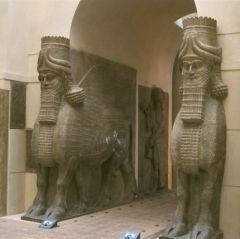
|
Lamassu
(winged, human- headed bull) from Citadel of Sargon II 720-705 BCE |
|
|

|
Assyrian archers pursuing enemies
Relief from the northwest palace of Ashurnasirpal II, Kalhu, Iraq, ca 875-860 BCE |
Frieze, composite view points within whole composition. We are mighty Assyrians and we will chase and kill them
|
|
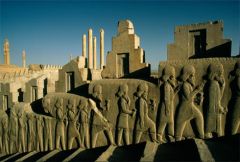
|
Persepolis, Iran, c 521-465 BCE
|
City destroyed by the Greek empire
|
|
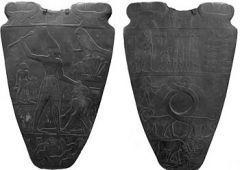
|
Palette of king Narmer, ca.3000-2920 BCE
|
Palette for makeup|Commemorative object|Two sides of single object|Narmer is bigger in scale
-polytheistic society -hybrid, men/animals -profile/composite -unification of upper and lower kingdom -pharaohs always look young and strong -template set with this palette for next generations -iconography reinforces power of pharaoh |
|
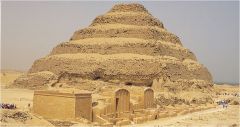
|
Imhotep "Stepped Pyramid and Mortuary Precint of Djoser", Saqqara, ca. 2630-2611 BCE
|
-Mastabas Stacked up on top of each other
|
|
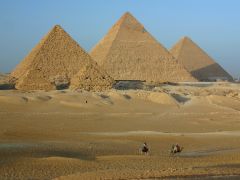
|
Great Pyramids of Gizeh
"2490" BCE |
|
|
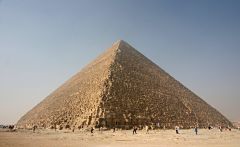
|
Khufu, ca 2551-2528 BCE
"2490" |
|
|
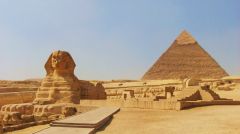
|
Khafre, ca 2520-2494
"2490" |
|
|
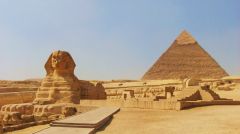
|
Great Sphynx, Gizeh, ca. 2520-2494
"2490" |
|
|
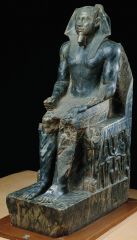
|
Khafre Enthroned, Gizeh, ca. 2520-2494
|
Ka Sculpture, Ka resides here
Family bring offerings and food Horace is behind him |
|
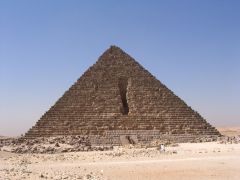
|
Menkaure, ca.2490-2472 BCE
"2490" |
|
|
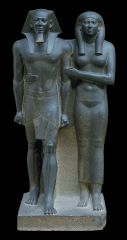
|
Menkaure and Khamerernetby, Gizeh, ca.2490-2472
"2490" & Wife |
Stepping forward all powerful and strong
False beard sign of office |
|

|
Ti watching hippopotamus hunt, mastaba of Ti, Saqqara, ca. 2450-2350
|
Scale
Reeds with birds watching them from top |
|
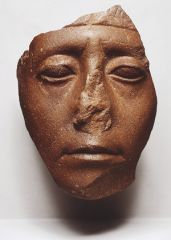
|
Senusret III, ca. 1860 BCE
Middle Kingdom |
1861 AD Bad times "civil war"
Nile does not flood, no food If people are starving , you're very vulnerable to invaders They bring superior technology, Bronze Age,.chariots, Unusual in Egyptian art, sad complexion, worn down |
|

|
Rock cut tombs, Beni-Hasan, ca. 1950-1900 BCE
Middle Kingdom |
Cut into mountain and more intricately design to prevent thieves from stealing.
Standard tomb for pharaoh to middle class. |
|
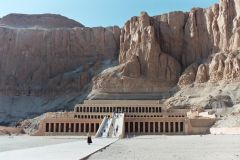
|
Mortuary Temple of Hatshepsut, Deir el-Bahri, ca. 1473-1458 BCE
|
She ruled in place of here young son.
|
|
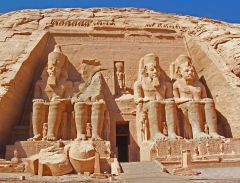
|
Temple of Ramses II, Abu Simbel, ca. 1290-1224 BCE
"1250" |
|
|

|
Temple of Amen-Re, Karnak, ca. 1290-1224
|
Not funerary
Pylones Distinctly different than Mesopotamian Temples Always stretch out, direct access Form follows function Mesopotamian temples had bends |
|
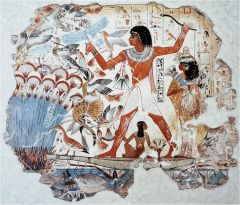
|
Fowling Scene, Tomb of Nebamun, Thebes, ca. 1400-1350 BCE
|
Hierarchy scale, composite view
Egyptians didn't paint unrealistic humans because they could not, but because they choose not to. Animals look very real |
|
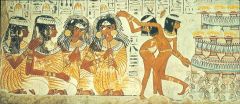
|
Musicians and Dancers, Tomb of Nebamun, ca. 1400-1350 BCE
|
Registers,
Dancers are very curvy so therefore must be very low on social scale |
|

|
Akhenaton, Temple of Aton, Karnak, ca. 1353-1335 BCE
|
Formed new religion. New god:Aton
One god, no other gods. |
|
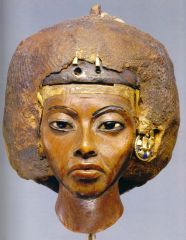
|
Tiye, Ghurab, ca 1353-1335 BCE
|
Nefertiti's mother in law
4 inches tall Made of wood Probably from Ethiopia Not seen before |
|
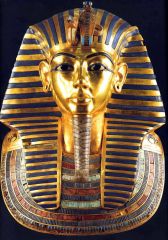
|
Death mask and Innermost coffin of Tutankhamen, Thebes, ca. 1323 BCE
|
Four coffins before you got to this
Gold Revert to old religion Style still influenced by previous ruler "Soft, elongated neck, soft face,,stomach pooch |
|
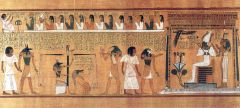
|
Last judgment of Hu-Nefer, Thebes, ca. 1290- 1280 BCE
|
|
|
|
Old Kingdom
|
The old Kingdom was the first golden age of Egyptian art and architecture, the time when three pharaohs of the Fourth Dynasty erected the Great Pyramids at Gizeh, the oldest of the Seven Wonders of the ancient world. The pyramids were emblems of the sun on whose rays the pharaohs ascended to the heavens after their death.
|
|
|
|
Middle Kingdom
|
After an intermediate period of civil war, Mentuhotep II (r. 2050- 1998 BCE) reestablished central rule and founded the Middle Kingdom.
|
|
|
|
New Kingdom
|
During the New Kingdom, Egypt extended its borders to the Euphrates River in the east and deep into Nubia in the south.
|
|
|
|
Ka
|
-In ancient Egypt the immortal human life force.
-"essence of a person" -"soul" |
-Moves on to an afterlife after you die
-preserve the body and possessions for afterlife |
|
|
Mastaba
|
Arabic, "bench." An ancient Egyptian rectangular brick or stone structure with sloping sides erected over a subterranean tomb chamber connected with the outside by a shaft.
|
|
|
|
Stepped Pyramid
|
The Stepped Pyramid seems to be composed of a series of mastabas of diminishing size, stacked atop another to form a structure that resembles the great Mesopotamian ziggurats.
|
|
|
|
Necropolis
|
Greek, "city of the dead." A large burial area or cemetery.
|
|
|
|
Sarcophagus
|
Latin, "consumer of flesh." A coffin, usually of stone.
|
|
|
|
Rock-cut tomb
|
Hollowed out of the cliffs, these tombs often have shallow columnar porch, which leads into a columned hall and burial chamber.
|
|
|
|
Mortuary temple
|
In Egyptian architecture, a temple erected for the worship of a deceased pharaoh.
|
|
|
|
Hypostyle hall
|
A hall with a roof supported by columns.
|
|
|
|
Pylon
|
The wide entrance gateway of an Egyptian temple, characterized by its sloping walls.
|
|

